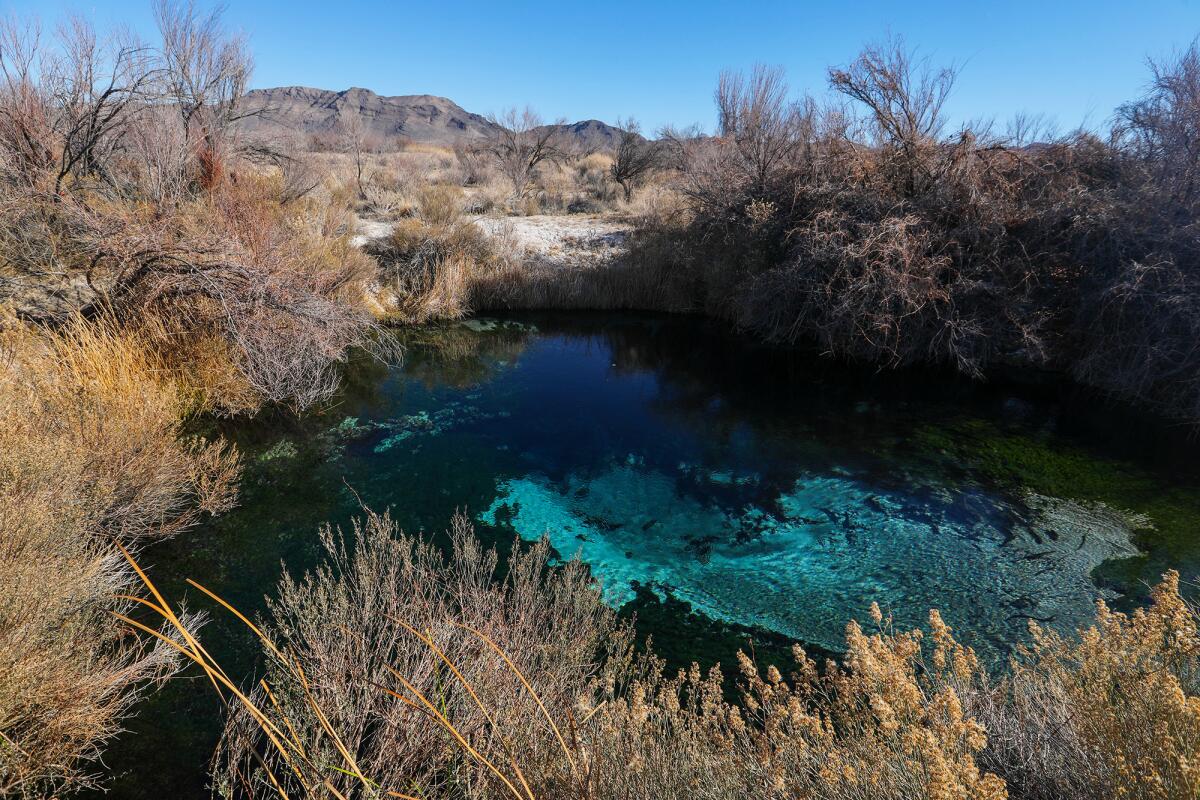Boiling Point: It’s just getting hotter

- Share via
This story was originally published in Boiling Point, a newsletter about climate change and the environment. Sign up here to get it in your inbox.
In case you hadn’t noticed, it’s getting hot.
Heading into the weekend, the National Weather Service’s Phoenix office warned that temperatures this week could be “some of the hottest we have ever seen.” The weather service wrote that its computer models looking out over the next two weeks for the desert Southwest “do not show an end to this heat wave,” as the Washington Post’s Ian Livingston noted.
The heat won’t be quite as bad near the coast. But parts of Southern California are expected to reach 112 degrees.
“The Earth this week appears to be hotter than any week than we’ve observed since we’ve been recording temperatures,” UCLA climate scientist Daniel Swain said in a live YouTube session — and that was before the Southwestern heat wave.
As fossil fuel combustion raises global temperatures, more people are dying. Just this week, a new study found that last summer’s brutal heat in Europe may have resulted in more than 61,000 deaths — with higher numbers forecast for the coming years.
It’s not just heat getting worse.
This story by Bob Berwyn for Inside Climate News is about as scary as it gets. He writes that June 2023 “may be remembered as the start of a big change in the climate system, with many key global indicators flashing red warning lights amid signs that some systems are tipping toward a new state from which they may not recover.” Those warning signs include record-low sea ice around Antarctica, unprecedented ocean warming, rampant wildfires in Canada and the hottest June ever measured globally.
This is why I write about renewable energy — and why it’s so crucial to navigate the challenges to building more of it.
For now, temperatures will keep rising almost no matter what we do. But there’s no point in giving up. The worst-case scenario is that we fail. The best-case scenario is we prevent a few degrees of warming and save a lot of lives. It’s still in the cards.
More to come Thursday. Until then, here’s what’s happening around the West:
TOP STORIES

California reached a deal with the big trucking companies to reduce diesel pollution and speed the transition to electric vehicles, heading off a high-stakes lawsuit. Details here from the Washington Post’s Timothy Puko, who writes that California officials made a few concessions as part of the agreement, which could be adopted by several other states. At least one Southern California trucking company is already switching to electric big rigs for its Starbucks deliveries. LAist’s Erin Stone spent time with a driver who was initially skeptical but now loves his electric truck. It’s cooler, quieter and less polluting of the air he breathes.
My L.A. Times colleagues Robert Gauthier and Melissa Gomez put together a series of captivating portraits of San Joaquin Valley residents coping with flooded communities and inundated farm fields, as the region struggles to recover from epic storms. The portraits include a Native American general contractor, a family farmer, a pastor, two levee repairmen and a woman who runs an emergency aid thrift shop, among others. Gauthier’s black-and-white photographs are especially powerful.
“People should also have the opportunity to live on the coast, not just visit the coast.” So says California Assemblymember David Alvarez, one of several state lawmakers who are pushing to allow more construction of affordable housing along or near the coast. But Alvarez and his colleagues have come up against opposition from the powerful California Coastal Commission, which opposes legislation that would fast-track apartment development in areas that haven’t met state housing goals — including areas near the water, CalMatters’ Ben Christopher reports. The commission sees rising seas as one of several reasons why such development may be a bad idea. L.A. Times columnist Patt Morrison, meanwhile, writes that climate change may spell the end of California’s most beautiful train ride — the Pacific Surfliner along the coast between San Diego and San Luis Obispo.
THE ENERGY TRANSITION
San Diego is building eight solar-plus-storage microgrids at city facilities — and there’s opportunity for more local clean energy systems across the state. The San Diego Union-Tribune’s Rob Nikolewski wrote about the microgrids, which city officials expect will save taxpayers $6 million in electricity costs over 25 years, in addition to reducing planet-warming pollution from fossil fuels. Similar local systems powered mostly by renewable energy could help many more California communities keep the lights on during intentional power outages designed to prevent wildfire ignitions, according to a new study. But it’s not clear how many of those communities could afford the high up-front costs, as Emma Foehringer Merchant writes for Inside Climate News.
Researchers at Utah’s federally funded FORGE geothermal site revealed a potentially important breakthrough in their quest to allow underground heat to be tapped for round-the-clock renewable energy in more places. The Deseret News’ Amy Joi O’Donoghue explained the breakthrough, which could ultimately help Western states keep the lights on without fossil fuels after sundown. I’ve written previously about geothermal power plants, which for now are relatively few in number — and which, similar to solar farms and wind turbines, have increasingly faced wildlife concerns from conservation activists.
A big climate problem that tends to go under the radar: logging. My colleague Tony Briscoe wrote about a new study finding that global demand for wood is expected to grow more than 50% by 2050, ratcheting up heat-trapping pollution. “Vast emissions from harvesting wood have mostly been ignored because of faulty carbon accounting,” one study author said. Not great.
POLITICAL CLIMATE
A new study finds that a whole bunch of U.S. cities and counties with ambitious climate plans have employed lobbyists who have also worked for fossil fuel companies. That includes Los Angeles and several other jurisdictions in California. Some observers say the research raises questions about whether those lobbyists are working in the best interests of local governments trying to phase out fossil fuels, the Guardian’s Dharna Noor writes. The L.A. City Council, meanwhile, voted to study the formation of a public bank that could fund renewable energy, affordable housing and more, The Times’ Charlotte Kramon reports.
The Chemehuevi Indian Tribe’s reservation fronts about 30 miles of the Colorado River along the California-Arizona state line, on the California side. But the tribe isn’t able to use the vast majority of its Colorado River water, with most of its allocation flowing downstream to Southern California cities. That’s according to this startling investigation by ProPublica’s Mark Olalde and Umar Farooq and High Country News’ Anna V. Smith. Arizona makes it even harder for tribes to access their Colorado River water, with Farooq explaining in a separate story how an Arizona court decision dealing with water rights has severely limited economic growth potential for the Hopi Tribe. “I would define it as modern-day genocide,” the tribal chairman says.
The Colorado River’s newest — and youngest — power player is 27-year-old J.B. Hamby, chair of the Colorado River Board of California and vice president of the Imperial Irrigation District. KUNC’s Alex Hager profiled Hamby, who has already played a key role in the interstate deal-making so crucial to surviving 21st century life in the West. I’ve been tracking Hamby’s career for several years, having first written about him when he was 24 and making his initial run for public office in the Imperial Valley.
AROUND THE WEST

Nevada’s Ash Meadows National Wildlife Refuge is an oasis in the Mojave Desert, with spring-fed pools that support a vibrant web of life. Now a company is seeking to drill for lithium a few thousand feet from the refuge’s northern springs, in yet another example of the conflict between confronting the climate crisis — lithium is a key ingredient in batteries for electric cars and solar energy storage — and protecting dwindling wildlife habitat and natural landscapes. The Las Vegas Review-Journal’s Colton Lochhead wrote about the conflict — and about a lawsuit filed by the Center for Biological Diversity and the Amargosa Conservancy seeking to compel the federal government to block the drilling, which the groups worry would drain the springs.
A fascinating new study out of Wyoming’s Bridger-Teton National Forest finds that human sounds — even from relatively quiet hikers — can change how animals behave. More research is needed to determine how serious the effects are, Christine Peterson writes for High Country News. But the research serves as a reminder that it doesn’t take much for human footprints to alter the natural world. Speaking of which: Are new mountain trails a boon for recreation and public health in Western towns? Or are they an environmental scourge that will bring gentrification in the form of newly relocated remote workers? That question is at the heart of a growing number of clashes in New Mexico and throughout the West, Reuters’ Andrew Hay writes.
The story of Tuffy the baby red-tailed hawk — kidnapped and briefly raised by a bald eagle — reached a swift end. I’ll let my colleague Susanne Rust share the tale in all its sad detail. But basically, the eagle mother turned on her adopted chick.
TWO MORE THINGS
I very much enjoyed sharing lessons from the climate change beat — for journalists and readers alike — in a recent talk for the University of Rhode Island’s Metcalf Institute, as part of its annual lecture series. You can watch here if you’re interested.
On an unrelated note, I watched the Disney film “Tron: Legacy” the other day, and it references global warming. As the son of Jeff Bridges’ character catches up his dad on several decades of human history, he casually mentions that ice caps are melting.
“Tron: Legacy” came out in 2010. Thirteen years later, there’s no excuse for filmmakers to ignore the reality we face.
We’ll be back in your inbox Thursday. To view this newsletter in your Web browser, click here. And for more climate and environment news, follow @Sammy_Roth on Twitter.
Toward a more sustainable California
Get Boiling Point, our newsletter exploring climate change, energy and the environment, and become part of the conversation — and the solution.
You may occasionally receive promotional content from the Los Angeles Times.






